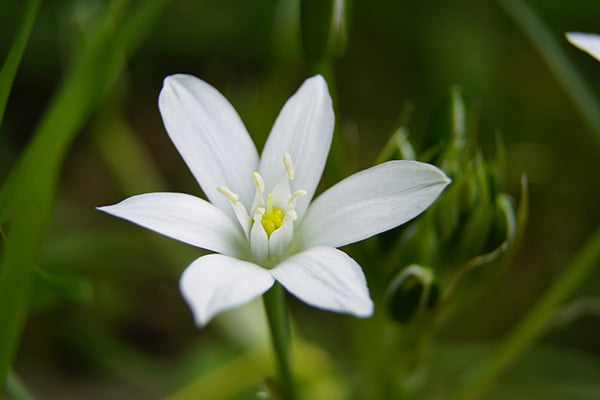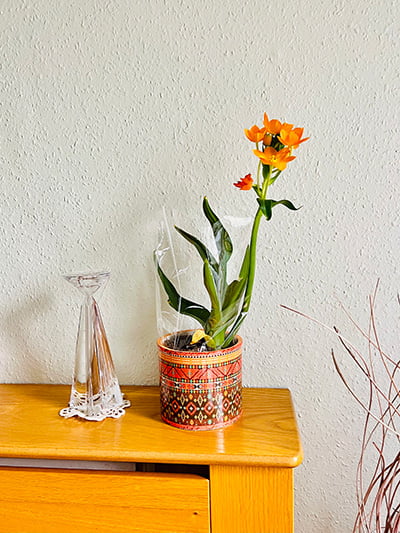The Star of Bethlehem plants produce large amounts of the sweetest white flowers. Unassuming in their appearance, small clumps of grassy leaves burst out in star-shaped flowers lasting from early spring through early summer. But these beautiful flowers can be a bit of a handful! They're almost alarmingly easy to grow, but they take some effort to keep contained!
Below, we'll talk about what you need to know to grow Star of Bethlehem in your own plants or garden beds. And perhaps more importantly, we'll talk about what you'll need to do to make sure these sweet flowering plants behave!
Botanical Name
Common Name
Plant Type
Mature Size
Sun Requirement
Soil Type
Hardiness Zone
Pet Friendly
Ornithogalum umbellatum
Star of Bethlehem
Perennial
12 to 18 inches tall and 6 to 12 inches wide
Full sun to partial shade
Loamy
3-9
No
What Are the Star Of Bethlehem Flowers?
The Star of Bethlehem flower (Ornithogalum) is a beautiful flowering bulb that will come back year after year. It beautifies your flower bed with numerous small white flowers. The six white petals of each flower have a light green stripe underneath and look like a tiny starburst.
The dark green leaves of the Star of Bethlehem look similar to grass or even garlic and wild onion. Because of this, you can allow them to grow freely in your yard. They'll blend in, and you'll be rewarded with a carpet of white flowers every early spring! Each stem will produce between 10 and 20 flowers on each stem, which open a bit before noon each day and closes at sunset. By early summer, the flowers will start to yellow and fall away. In mid-summer, they will spread their seeds. The star of Bethlehem spreads naturally, and the bulbs will grow into clusters 6 inches wide.
The Star of Bethlehem plant has many nicknames, including grass lily, bird's milk, nap-at-noon, and eleven o'clock lady. There are over 200 species of Star of Bethlehem flower native to the Mediterranean region of Europe, western Asia, and Africa. The differences in these species have made it so that some botanists classify Ornithogalum as part of the hyacinth family, while others consider it part of the lily family. However, all species have invasive tendencies and will quickly take over their flower bed. In many regions, they have escaped cultivation and become a nuisance.
Ornithogalum umbellatum - The most common Star of Bethlehem species. A bundle of linear leaves tops out at 12 inches high with beautiful white flowers.
Ornithogalum nutans - This species is taller than others at 16 inches tall, and the flowers have a more prominent green stripe that tints the upper surface of the white petals.
Ornithogalum dubium - Unique to the Star of Bethlehem family, this species features orange flowers!
Ornithogalum arabicum - As the name suggests, this species is native to Arabia and thrives in the dry heat of USDA zones 9 and 10.
Ornithogalum thyrsoides - You might mistake this species for the Ornithogalum nutans, as they look almost identical. However, the flowers on this species are bright white.

Star Of Bethlehem Flower Care Requirements
Light
The Star of Bethlehem grows best in sunny locations, and they should receive at least 6 hours of direct full sun each day. If your afternoon sun is particularly intense, place your Star of Bethlehem plants in a location that receives partial shade later in the day.
Water
This hardy plant is unlikely to need any watering other than what rain naturally provides. In USDA zone 3, the Star of Bethlehem grows best with a layer of mulch. This mulch traps moisture and heat.
Temperature
Star of Bethlehem grows in USDA zones 3 through 10 and can handle a wide range of temperatures. It is a winter bulb, and the flowers open in early spring, so chilly nights and light frosts don't pose much concern.
Soil
All of the Star of Bethlehem species are native to moderate-to-dry climates, and they will do great if they're growing in well-draining soil. If planting outdoors, avoid placing them in gardens where water tends to pool after a rainstorm.
Fertilization
These small flowering plants don't require many nutrients to thrive and will not require regular fertilization.
Propagation
Star of Bethlehem will readily propagate through bulb division. You won't need to encourage it at all. You may spend some time each spring trying to keep them at bay! However, you may live in a location where it's hard to source a Star of Bethlehem plant. If that's the case, here is how to propagate one through bulb division.
In late summer, use a shovel to dig up the bulbs of at least one plant.
Carefully pull off the offset bulbils that appear around the large main bulb.
Immediately replant both the bulbils and the parent bulbs in moist soil about 4 inches deep. The bulbils will bloom in two years!

Common Problems With the Star of Bethlehem Flower
It is highly unlikely that you will have any problems getting your Star of Bethlehem bulbs to thrive, and it's much more likely that you'll struggle to keep them contained! Because they are a highly toxic plant, are not native to the United States, spread prolifically, and crowd out native perennials, it's important that you keep them contained.
Plant Them In Containers
This blooming bulb will quickly grow to fill any container they're planted in. You will be amazed at how packed with bulbs your planter will be in only a few short years! Keeping your Ornithogalum umbellatum in a container will put boundaries on how much your plant can spread via bulb division.
Dig Up The Whole Bulb
When you see the Star of Bethlehem growing in a garden area where it doesn't belong, don't simply yank on the foliage. Those bulbs take a firm root and will continue to divide and grow. Instead, take the time to get a spade and dig up the whole bulb.
Deadhead Early
Some gardeners who love the Star of Bethlehem will let them grow in their yards. It makes for a beautiful sight in the spring! The key to keeping this under control is mowing. If you deadhead the flowers before the seeds develop, then the only way the plant can spread is through bulb division. Mowing deadheads the flowers frequently.
Is Star Of Bethlehem Flower Pet Friendly?
Star of Bethlehem contains two naturally-occurring poisons - cardenolides and bufadienolides - that affect heart function and are toxic to pets and humans alike. Because this plant is notorious for its ability to spread, take care that you contain it in your planters or garden beds, and keep it out of any pastureland.
